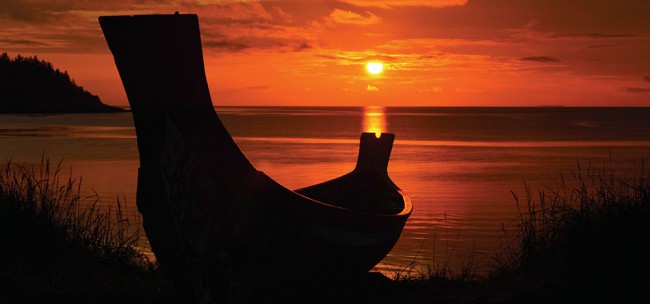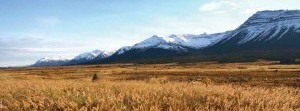
Photo Credit: Mary Helmer/Haida Heritage Centre
Anyone who considers Canada a dull and uncultured country clearly hasn’t experienced the rich heritage of northern BC, where hundreds of First Nations communities provide the region with a history rooted several millennia into the earth and traditions that significantly pre-date European arrival on the continent.
Although these cultures have existed since time immemorial, the tourism industry is only just beginning to realize the potential that they represent: for the economy, but also for spreading understanding about the nations whose culture evolved, and continue to thrive, in the North.
According to the Aboriginal Tourism Association of BC, the aboriginal tourism industry more than doubled between 2006 and 2011 and is expected to increase by an additional 50 percent by 2017. That means that while the traditions may be pre-historic, many of these tourism initiatives are new within the past decade, with more coming online every year.
They offer the opportunity to visit, learn, take part and take home perhaps the greatest souvenir ever: firsthand knowledge of a first peoples’ culture.
Haida House • www.haidahouse.com
Flanked by the Tlell River and Hecate Straight, just over the sand dunes to the east, the Haida House at Tllaal offers modest luxury amidst the wildness of Haida Gwaii. Hosting visitors from May through September, this Haida-owned lodge opened July 2012 and its rapidly growing popularity is a testament to the demand for aboriginal tourism.
“It’s just been a continuous increase,” manager Jöelle Rabu says. “The main thing people enjoy about Haida House is we are Haida owned and all our packages are authentic cultural tourism packages.”
Originally a bear hunting lodge on this west coast archipelago, when protests mounted against hunting the Haida black bear, the owners agreed to sell to the Haida Nation. Packages can be tailored to suit the guest, but often include return airfare from Vancouver, a visit with a Haida cultural ambassador, an eight- to 10-person guided tour of the island, a zodiac trip, and guided river-kayaking trips.
“The response has been overwhelming. It’s been so popular,” Rabu says. “There’s really no other place that offers everything we offer under one roof.” Even if you don’t spend the night, be sure to check out the dining room, which offers excellent local fare.
Haida Heritage Centre • www.haidaheritagecentre.com
The Haida Heritage Centre is built to resemble an ancient village that once stood in its place at Kay Llnagaay, or Sea Lion Town, near the southern tip of Haida Gwaii’s Graham Island. Owned by the Haida Nation and operated by Gwaalagaa Naay Corporation, the centre opened in 2007 and works in partnership with the Haida Gwaii Museum Society and Parks Canada.
During its busiest season, from May to September, the Haida Heritage Centre hosts daily weaving, canoe and pole tours. At times, visitors can also experience traditional Haida canoe excursions, bracelet-making workshops, films, cultural demonstration and performances.
But just having the opportunity to walk its breezy corridors and admire the peace and tranquility—not to mention the Haida cultural artifacts—that exist next to the serene Pacific Coast is a treat. A summer artist-in-residence program gives guests the opportunity to speak with local artists.
If you’re on the islands in August, the summer’s biggest event celebrates the centre’s anniversary on Aug. 15 with traditional dancing, singing, games and an evening traditional dance competition.
Metlakatla Wilderness Trail • www.metlakatlatrail.ca
Located a 15-minute boat ride from Prince Rupert, the Metlakatla Wilderness Trail offers the opportunity to literally walk in the footsteps of the coast’s ancient inhabitants. The trail, which opened in 2011, descends from the modest community of Metlakatla into forests of cedar, hemlock and Sitka spruce. It continues for 10 km up the coast, with a campsite at seven km, although it’s best to check ferry schedules before planning to spend the night.
At one time, up to 10,000 Tsimshian lived along what is now Metlakatla Pass National Historic Site. What remains are trees scarred by past civilizations and shells castoff by ancient inhabitants. One shell midden (think pre-historic garbage dump) unearthed during trail construction is likely more than 5,000 years old.
Those travelling with wee ones needn’t worry trekking the entire trail: there’s much to explore within the first two kilometres, with boardwalks, a beachside picnic area, two suspension bridges and a pair of viewing towers 7.5 and 15 metres high, joined by a 100-metre-long bridge. Be aware that you’re limited by the ferry, which leaves Rupert first thing in the morning and doesn’t return to until 4 p.m.
Kitselas Canyon • www.kitselas.com
Farther inland, the Tsimshian people have occupied Kitselas Canyon for at least 5,000 years, according to archaeological and ethnographic evidence. The canyon, located 15 minutes east of Terrace, has been a National Historic Site since 1972 and in recent years the Kitselas First Nation has been developing its tourism potential.
“Ever since 1972 we’ve envisioned a cultural centre,” says tour coordinator Web Bennett. In 2005, the nation began building four long houses, each with its own purpose: one contains carving demonstrations (such as totem poles); one displays contemporary cultural items like paddles, bentwood boxes and cedar hats; one showcases wildlife, with taxidermy bears, wolves, cougars and mountain goats; and one showcases transportation, from canoes to paddle boats to the railway—the reason the settlement sits where it does.
From the long houses, a one-kilometre interpretive trail leads visitors to the canyon and viewing deck, explaining the traditional use of natural resources found along the way. Canyon tours are offered from May to September.
’Ksan Historical Village • www.ksan.org
Located just outside Old Hazelton at the confluence of the Bulkley and Skeena rivers, ’Ksan is a replicated ancient village and museum that marks an important traditional fishing site and transportation hub.
Representing a culture that continues to thrive in this area, the ceremonial dress housed in the museum is still owned and used by the local Gitxsan First Nation and pieces will often disappear temporarily—borrowed by their owners for an important event or feast. The tour guides are also local: people whose ancestors have called this place home for millennia.
’Ksan is housed in seven traditional longhouses that gaze out toward the Bulkley as it flows into the Skeena. The first is home to a museum and gift shop, followed by a carving workshop, studio, and Eagle, Fireweed, Wolf and Frog houses. For $5 visitors can walk the grounds, but a guided tour is well worth the $10 admission.
Moricetown Interpretive Centre • www.mbed.ca
Located 30 km west of Smithers, Moricetown offers cultural sightseeing right next to Highway 16. Travellers are likely to be lured first by the thundering canyon, which attracts viewers and photographers who swerve into a handy pullout to take in its thundering majesty.
But the Moricetown Canyon is more than just a display of nature’s beauty and awe: This spot has offered sustenance to the Wet’suwet’en people for thousands of years and continues to be an important fishing site today. If you are lucky enough to be passing through during the late-summer salmon runs, take a moment to stretch your legs, observe the fishermen as they ply their ancient trade, and learn a little about local culture—while watching your step on the canyon’s perilous rocks!
If this whets your appetite for more local culture, the Moricetown Interpretive Centre is a new-looking building that can be seen overlooking the canyon and offers artifacts, such as recently excavated stone tools, and photos telling Wetsu’wet’en history.
If you feel inclined to stay a while longer, an adjacent campground and RV park offers a place to rest your head. The interpretive centre and campground are open May to September.
Fort Babine Lodge
If you’re keen to get off the beaten path, Fort Babine Lodge is located on Babine Lake, about 100 km north of Smithers along Babine Lake Forest Service Road. While it is accessed by a rough dirt road, it offers eight lakefront log cabins where you can rest in style within easy commuting distance of some of BC’s best fishing at Rainbow Alley and the Babine River.
As part of a tourism strategy being undertaken by the Lake Babine Nation to further develop its cultural resources, the lodge is increasing its adventure tourism offerings with cultural components like visiting historic village sites and traditional salmon smoking. The strategy is expected to be completed early summer, so watch for more tourism developments in the coming months. For more information, find Fort Babine Lodge on Facebook.
UNBC Experiential Tourism • www.unbc.ca/continuing-studies
As part of the University of British Columbia’s Continuing Education program, Experiential Tourism offers the opportunity to witness northern BC’s thriving cultures in action. Along with trips to historic Anyox (see story page 24), the program provides hands-on access to First Nations’ experiences that might otherwise remain inaccessible to visitors.
In March, the program offered a three-day Nass River Oolichan Experience that—along with food, transportation and accommodation—featured one of the most important traditional fisheries in the Northwest. This August, participants can learn more about northern First Nations’ connection to our waterways and natural resources through a sturgeon-tagging expedition to the Grand Canyon of the Fraser River, 70 km east of Prince George.
Being developed in partnership with the Lheidli T’enneh First Nation, visitors would tour the river by jet boat, learning about this species-at-risk from a First Nations’ perspective and having the opportunity to both catch and tag the mammoth fish: “A First Nations representative will provide context about why these fish are so important and why we can’t lose them,” UNBC Continuing Studies coordinator Rob Bryce says.
Jasper National Park’s Aboriginal Day • www.pc.gc.ca
If your travels take you into Alberta, be sure to check out the National Aboriginal Day celebrations in picturesque Jasper—traditionally a “cultural crossroads,” according to Jasper National Park aboriginal liaison Sherrill Meropoulis.
Aboriginal Day has been celebrated annually in the national park since 2006, with a different First Nations community hosting the events each year and other indigenous groups invited to be part of the celebrations.
“Jasper was historically a really important part of the ceremonial areas, trade routes, and hunting and gathering areas,” Meropoulis explains. Nations from as far away as the Shuswap First Nations, in southeast BC, had a historical connection to the area, along with the Stoney, Cree and Metis.
Every celebration entails traditional drumming and dancing and, depending on the host nation, sometimes storytelling, teepee teachings, cultural exhibits, plant medicine walks and beaver skinning—while perhaps ironic to be skinning the nation’s symbol in a national park, it offers insight into the still-thriving First Nations cultures in the area.
“It provides visitors with the opportunity to understand that hunting and trapping are still an important part of the practices,” Meropoulis says. Festivities happen on the Saturday closest to Aboriginal Day, this year taking place on June 20 from 11 a.m. until 4 p.m. on the lawn at the Parks Canada Info Centre in downtown Jasper.















